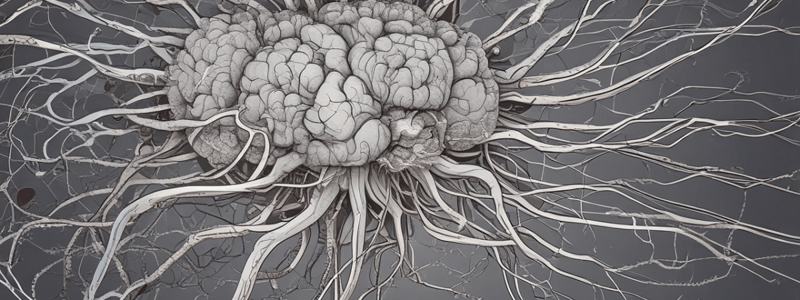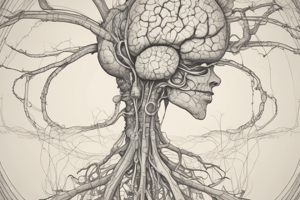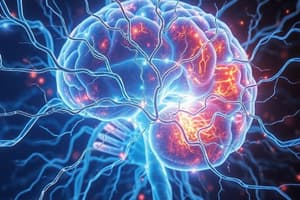Podcast
Questions and Answers
What is the primary function of the nervous system?
What is the primary function of the nervous system?
- To coordinate and control all essential bodily functions (correct)
- To produce hormones and enzymes
- To regulate body temperature
- To provide higher cognitive functions such as memory and learning
What is the main difference between the central nervous system and the peripheral nervous system?
What is the main difference between the central nervous system and the peripheral nervous system?
- The central nervous system is responsible for controlling involuntary movements, while the peripheral nervous system is responsible for controlling voluntary movements
- The peripheral nervous system is responsible for processing information, while the central nervous system is responsible for transmitting information
- The central nervous system is responsible for controlling voluntary movements, while the peripheral nervous system is responsible for controlling involuntary movements
- The central nervous system is responsible for processing information, while the peripheral nervous system is responsible for transmitting information (correct)
What is the autonomic nervous system responsible for?
What is the autonomic nervous system responsible for?
- Enabling higher cognitive functions such as memory and learning
- Controlling voluntary movements
- Regulating various involuntary functions such as heart rate and blood pressure (correct)
- Processing sensory information
What is the somatic nervous system responsible for?
What is the somatic nervous system responsible for?
What is the primary focus of neuroscience?
What is the primary focus of neuroscience?
What is the definition of neuroscience?
What is the definition of neuroscience?
What is the central nervous system composed of?
What is the central nervous system composed of?
What is the main function of the brain?
What is the main function of the brain?
Which philosopher is associated with empiricism?
Which philosopher is associated with empiricism?
What is the term for the study of how environmental factors affect gene expression?
What is the term for the study of how environmental factors affect gene expression?
Which bone forms the lower jaw and is the only movable joint of the cranium?
Which bone forms the lower jaw and is the only movable joint of the cranium?
What is the term for the part of the brainstem that connects the pons to the spinal cord?
What is the term for the part of the brainstem that connects the pons to the spinal cord?
Which of the following is NOT a singular bone forming the neurocranium?
Which of the following is NOT a singular bone forming the neurocranium?
What is the term for the passage through which the medulla oblongata passes?
What is the term for the passage through which the medulla oblongata passes?
Which part of the brain is responsible for regulating emotions and motivation?
Which part of the brain is responsible for regulating emotions and motivation?
What is the term for the bony structure that forms the base of the skull?
What is the term for the bony structure that forms the base of the skull?
What is the primary focus of David Eagleman's journey of investigation?
What is the primary focus of David Eagleman's journey of investigation?
In the context of neuroscience, what is the estimated number of connections between brain cells?
In the context of neuroscience, what is the estimated number of connections between brain cells?
Who is the Nobel laureate who proposed 5 principles about the relationship between genes, brain, and behavior?
Who is the Nobel laureate who proposed 5 principles about the relationship between genes, brain, and behavior?
What is the primary theme of the questions asked in the context of neuroscience and human behavior?
What is the primary theme of the questions asked in the context of neuroscience and human behavior?
What is the term used to describe the debate about the relative influence of genetic and environmental factors on human behavior?
What is the term used to describe the debate about the relative influence of genetic and environmental factors on human behavior?
What is the estimated year of Eric Kandel's Nobel Prize win?
What is the estimated year of Eric Kandel's Nobel Prize win?
What is the primary focus of neuroscientists at the Behavioral Level?
What is the primary focus of neuroscientists at the Behavioral Level?
What is the prevalence of neurological disability in the population according to the Association of British Neurologists?
What is the prevalence of neurological disability in the population according to the Association of British Neurologists?
What is the primary cause of Nervous System Disorders according to the text?
What is the primary cause of Nervous System Disorders according to the text?
What is the name of the book that describes how our life shapes our brain and how our brain shapes our life?
What is the name of the book that describes how our life shapes our brain and how our brain shapes our life?
At what level do neuroscientists study the function of individual neurons?
At what level do neuroscientists study the function of individual neurons?
What is the name of the Spanish neuroscientist who is mentioned in the text?
What is the name of the Spanish neuroscientist who is mentioned in the text?
What percentage of medical emergency admissions are due to neurological disorders?
What percentage of medical emergency admissions are due to neurological disorders?
What is the term for a temporary blockage of the blood flow to the brain?
What is the term for a temporary blockage of the blood flow to the brain?
What is the term for a condition where there is a gradual loss of function of neurons?
What is the term for a condition where there is a gradual loss of function of neurons?
At what level do neuroscientists study the function of groups of neurons?
At what level do neuroscientists study the function of groups of neurons?
What is the primary function of the dura mater?
What is the primary function of the dura mater?
Which artery is the largest of the three paired arteries supplying the meninges?
Which artery is the largest of the three paired arteries supplying the meninges?
What is the role of the choroid plexus in the brain?
What is the role of the choroid plexus in the brain?
Where does the cerebrospinal fluid exit from the ventricular system?
Where does the cerebrospinal fluid exit from the ventricular system?
What is the role of the arachnoid granulations in cerebrospinal fluid circulation?
What is the role of the arachnoid granulations in cerebrospinal fluid circulation?
What is the location of the middle meningeal artery?
What is the location of the middle meningeal artery?
What is the connection between the arachnoid mater and the pia mater?
What is the connection between the arachnoid mater and the pia mater?
What is the role of the pia mater in the brain?
What is the role of the pia mater in the brain?
Flashcards are hidden until you start studying
Study Notes
Introduction to Neuroscience
- Neuroscience is the science of the brain and nervous system.
The Nervous System
- The nervous system is the main controlling and communicating center of the body.
- It coordinates and controls all essential bodily functions, processes information from the environment, and enables the body to respond accordingly.
- The nervous system provides higher cognitive functions, such as memory, learning, thinking, planning, decision making, social cognitive processes, motivation, and emotions.
Central and Peripheral Nervous System
- The nervous system consists of the central nervous system (CNS) and peripheral nervous system (PNS).
- The CNS includes the brain and spinal cord, while the PNS includes nerves that connect the CNS to the rest of the body.
What Neuroscientists Do
- Neuroscientists study the nervous system at different levels of inquiry, including:
- Behavioral level: studying the neural basis of behavior.
- System level: studying the various parts of the nervous system.
- Local circuit level: studying the function of groups of neurons.
- Single neuron level: studying what individual neurons do.
- Synapse level: studying what happens at the synapse.
- Membrane level: studying what happens at ion channels on a neuronal membrane.
- Genetic level: studying the genetic basis of neuronal function.
Why Medics Should Learn About Neuroscience
- Neurological disorders are extremely common, accounting for one in eight consultations in general practice and 20% of medical emergency admissions.
- A wide range of medical doctors still lack knowledge and skills in clinical neuroscience.
Nervous System Disorders
- Can be caused by internal or external factors, including:
- Vascular problems, congenital problems, brain tumors, thyroid dysfunction, and high or low blood sugar (internal causes).
- Exposure to toxins, infections, overuse of drugs, trauma, and nutritional deficiencies (external causes).
- Examples of nervous system disorders include:
- Gradual loss of function (degenerative): Parkinson's disease, Huntington's disease, Alzheimer's disease, peripheral neuropathies, and amyotrophic lateral sclerosis.
- Acute problems: stroke, subarachnoid hemorrhage, transient ischemic attack, seizures, and mental health issues.
- Neurodevelopmental problems: autistic spectrum disorders, dyslexia, and other developmental disorders.
Brain Structure and Function
- The brain is made up of billions of brain cells and trillions of connections.
- The brain regions include:
- Frontal lobe
- Thalamus
- Midbrain
- Pons
- Medulla oblongata
- The brain fits into the cranium, with the cerebral cortex divided into four lobes: frontal, parietal, temporal, and occipital.
Meninges and CSF Circulation
- The meninges are protective coverings of the brain and spinal cord, consisting of:
- Dura mater (outermost)
- Arachnoid mater (middle)
- Pia mater (innermost)
- The middle meningeal artery is a branch of the maxillary artery that supplies the dura mater and calvaria.
- The Circle of Willis is a critical structure for cerebral blood flow.
- Cerebrospinal fluid (CSF) is formed in the ventricles, circulates through the subarachnoid space, and is re-absorbed into the systemic veins.
Brainstem and Cranial Nerves
- The brainstem connects the brain to the spinal cord.
- The spinal cord is protected by meninges, including the dura mater, arachnoid mater, and pia mater.
Studying That Suits You
Use AI to generate personalized quizzes and flashcards to suit your learning preferences.




